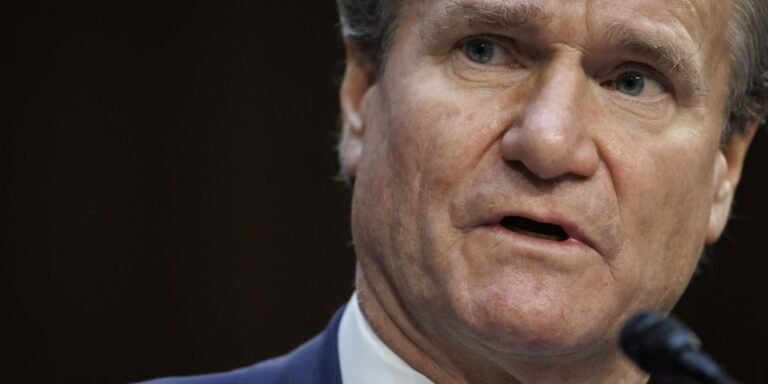
[ad_1]

Whereas many on Wall Road are pining for a reduce to the bottom charge from the Fed, Bank of America CEO Brian Moynihan appears comparatively relaxed about when—or even when—which may occur.
The banking boss—whose work has been lauded by the likes of Warren Buffett—stated his group’s speculation is that the Jerome Powell-led Fed will decrease charges 4 instances in 2024. That’s one increased than preliminary indications offered by the Fed’s dot plot (a chart up to date quarterly projecting the rate of interest’s short-term strikes) however two decrease than the Wall Road consensus of six cuts.
And whereas many on the road is likely to be banking on this state of affairs, Moynihan isn’t hanging his hat on it. In actual fact, it might really be excellent news for his establishment if the Fed didn’t reduce charges as early as predicted.
If the Fed doesn’t reduce charges quickly “from our firm’s perspective, that truly helps a bit of bit,” Moynihan told CNBC Friday. He defined that is “as a result of [of] the huge quantity of quick floating charge devices we’ve got on the asset facet and the money, the $500 billion—virtually $600 billion of money—we put with the Fed in a single day in very quick Treasuries.”
Furthermore, Moynihan laid out {that a} delay to cuts may gain advantage the buyer. Issues about inflationary pressures are nonetheless chiming: geopolitical tensions such because the Russian invasion of Ukraine and the Israel-Hamas warfare are pushing up oil costs, with transport reroutes across the Pink Sea additional adding to wider inflationary pressures.
As well as, the CPI (shopper worth index) figures released last week for December have been barely extra cussed than hoped for. Seasonally adjusted, costs on the index rose 0.3% in December following 0.1% in November. Total that introduced the benchmark to three.4% over the previous 12 months, nonetheless properly forward of the Fed’s 2% goal.
However regardless of these figures Moynihan notes that when the buyer started to indicate actual indicators of misery—or the “point of pain” as Bank of America has beforehand put it—the Fed listened. Moynihan stated that when the market “moved closely” and there was a way the Fed ought to cease climbing, they did.
Combining inflationary fears with this flexibility from the Fed may work properly, Moynihan stated: “For those who combine that each one collectively, in the long run of day, charges not coming down really assist us.”
Again to actuality
On high of that, the longer-term work of the Fed wasn’t to merely get inflation beneath management however was additionally to reintroduce customers to a standard degree of charges, Moynihan stated.
Shoppers have loved a interval of exceedingly low charges because the 2008 monetary disaster—the bottom charge solely crept above 2% for a brief time period in 2019 earlier than being axed once more to stimulate the economic system in the course of the pandemic. From 1971 to 2023 the typical base charge is 5.4%, according to Trading Economics, that means the present base charge of 5.25 to five.5% is definitely pretty common.
“The truth is that every little thing’s organising for them [the Fed] to have the ability to normalize the speed atmosphere,” Moynihan defined. “Given that you simply’re seeing shopper spending, which, for the primary a part of ’22 to ‘23, was up double digits, it’s now all the way down to 4 or 5% progress within the first a part of ’24.”
He added: “That’s extra per a lower-growth, low-inflation economic system. If you concentrate on the client… in the event that they’re slowing down their purchases, that’s not inflationary.”
If the steadiness suggestions too far, Moynihan stated, the Fed might be compelled into motion: “The consensus view [is] principally planning for a comfortable touchdown, which continues to be a serious step down in progress from the third quarter of ’23 to the primary quarter of ’24. You’re going to see progress from 4%-plus to about 1%.
“That’s a serious downdraft in progress and so the Fed in some unspecified time in the future must be cautious it doesn’t go beneath that.”
Not everyone seems to be so satisfied by the comfortable touchdown prediction. JPMorgan CEO Jamie Dimon admits he’s among the many extra cautious on Wall Road, telling Fox Business final week: “The federal government has an enormous deficit, which can have an effect on the markets. I’m a bit of skeptical on this Goldilocks state of affairs. I nonetheless suppose the probabilities of it not being a comfortable touchdown are increased than different folks.”
‘Goldilocks’ growth refers to a interval the place knowledge isn’t too scorching to immediate the Fed to tighten charges however not cool sufficient to be a sign of struggling company earnings.
Dimon stated a tougher recession could also be on the playing cards, however added the U.S. economic system may face up to that: “All of us in enterprise must be taught to cope with the ups and downs of the economic system. However I do suppose the crosscurrents are fairly excessive: the cash operating out, charges are excessive, QT [quantitative tightening] hasn’t occurred but.”
For Moynihan not less than, the outlook is rosier. He concluded: “These exterior elements may hasten [the Fed] to do extra quicker cuts or trigger them to carry on a bit of bit longer to verify the inflation doesn’t sit back in.”
[ad_2]